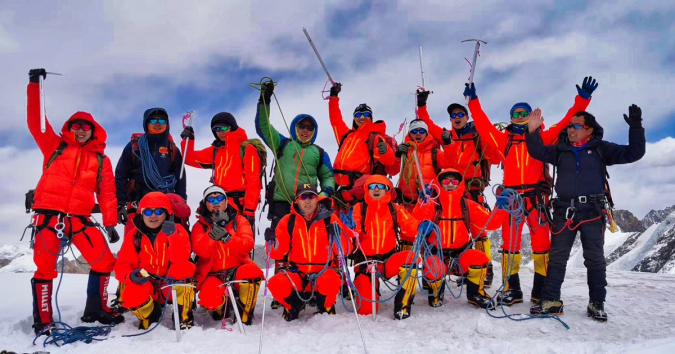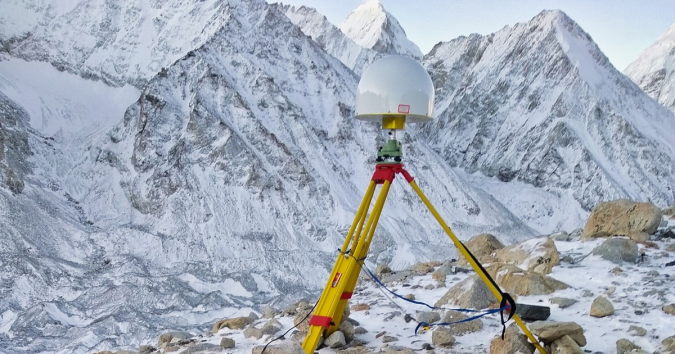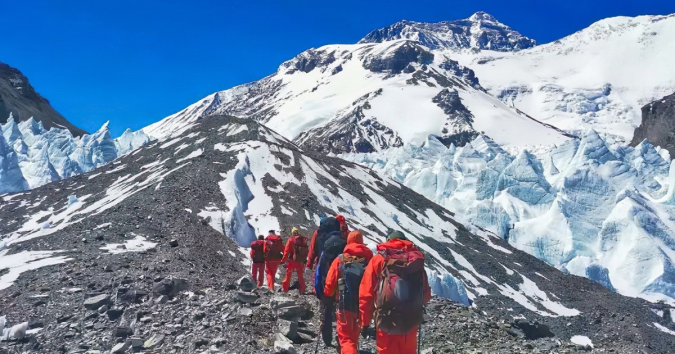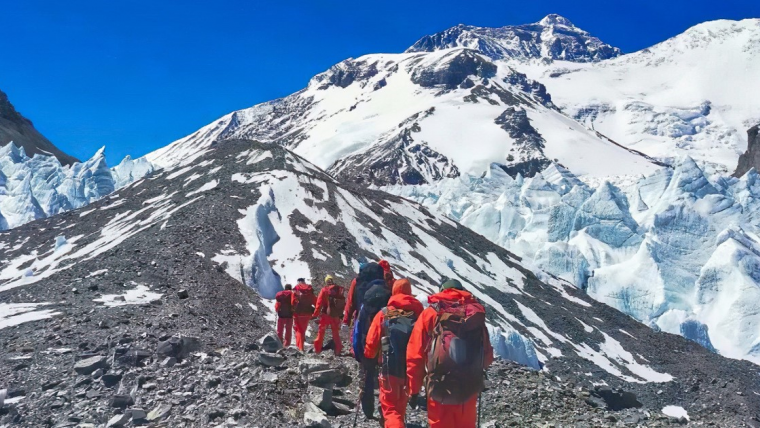CHC Navigation’s GNSS Receivers Reach the Peak of Everest
CHC Navigation’s P5 geodetic GNSS receiver has been used successfully by China's National Geodetic Survey Team and Mountaineer's Team to complete the 2020 Mount Everest Elevation Survey. This extreme GNSS surveying project leveraged the performance, reliability and operability of CHC Navigation’s receivers in very challenging temperature and altitude conditions. This was the first time that a team of Chinese surveyors had climbed the summit of Mount Everest, and was also the first time that BeiDou-based Chinese GNSS receivers had been used to measure the height of Mount Everest.
In order to promote research on the Mount Everest elevation and to ensure the scientific character and accuracy of measurements, the Ministry of Natural Resources mobilized the Shaanxi Bureau of Topography and Geographic Information Mapping (from the Chinese Academy of Topography and Mapping) to plan and implement the measurements of the Mount Everest elevation. The plan set out the technical guidelines and required that the Everest Elevation Project should be designed to achieve innovative and technological breakthroughs in several areas of research, including 1) the use of the BeiDou satellite navigation system to perform GNSS measurements, and 2) the use of Chinese surveying and mapping equipment to complete the task.

The Project Challenges
In October 2019, CHC Navigation (CHCNAV) received a request from the Ministry of Natural Resources to provide GNSS equipment for the 2020 Everest Elevation Project. A dedicated team combining different departments, from R&D to manufacturing, was set up. The team elaborated the specific technical requirements from the National Survey engineers, in particular the difficulties and challenges related to the altitude of Everest.
Measuring the height of Mount Everest, especially the summit, is a challenge, not only due to the limitations of the human body in such a high-altitude environment, but also in terms of the performance of the GNSS receiver itself. At over 8,800 metres, the temperature can be as low as -45°C and the atmospheric pressure is only 30kPa (compared to the normal 101kPa). This means that all the surveying equipment is exposed to both low temperature and low-pressure conditions. In addition, the operation of the instruments must be as simple and reliable as possible in such an extreme environment. Surveyors wear thick winter clothing and lack oxygen, making every movement challenging. Moreover, the measuring of the mountain peak must be completed at the first attempt, as re-measurement is impossible.
The Solution
To meet these stringent requirements, CHCNAV has provided GNSS receivers that have passed the most rigorous environmental and reliability tests. The entire solution, from the GNSS receivers to the accessories, has been optimized to ensure mission success from the very beginning.
The materials used supported a wide operating temperature range of -45°C to +85°C, including redesigned lithium-ion batteries offering 12 hours of operation even at extremely low temperatures, and antenna cables made from a specific compound material to avoid any cracking or signal attenuation.
To ensure reliable operation of the receivers in a low-pressure environment, the GNSS receivers have built-in waterproof and breathable valves to maintain internal and external pressures. The low-pressure tests replicated a 25kPa environment (corresponding to an altitude of 10,000 metres).

Additional ruggedized reinforcement prevented damage in the event of accidental receiver drop thanks to a robust design to keep the display and connectors safe. Following CHCNAV’s own tests, third-party organizations were commissioned to perform environmental testing and reliability verification, including storage and operating at high/low temperatures, vibration, shock, rain, dust, humid heat, salt fog and so on.
From November 2019 to March 2020, CHCNAV’s GNSS equipment was supplied to the National Photoelectric Rangefinder Testing Center – in line with the requirements of the China Academy of Surveying and Mapping – to perform the most rigorous evaluation. The fact that CHCNAV’s equipment has consistently outperformed similar products in many performance indicators played a role in the company’s GNSS receivers being selected to provide the peak altitude measurements of Everest in 2020.
Project Completion
CHCNAV officially donated its GNSS equipment to the National Survey Team at the Everest Elevation Survey Expedition Ceremony in Lhasa on 5 April 2020, and provided both product and technical training to the team. The 53 members of the first national survey team overcame the difficulties related to the environment, bad weather and the additional impact of COVID-19 and conducted a series of measurements – such as level, gravity and GNSS – on Mount Everest and in the surrounding areas.
30 of the 60 points of the GNSS control network were measured with CHCNAV GNSS receivers, including three of the seven Everest elevation intersection points. The CHCNAV GNSS receivers ultimately reached the summit and successfully completed the task.
According to CHCNAV, the successful completion of the Everest elevation measurement reflects the performance of the Chinese surveying and mapping industry, confirms BeiDou as a major part of the GNSS system and demonstrates the company’s technical success as a major player in the GNSS industry.


Value staying current with geomatics?
Stay on the map with our expertly curated newsletters.
We provide educational insights, industry updates, and inspiring stories to help you learn, grow, and reach your full potential in your field. Don't miss out - subscribe today and ensure you're always informed, educated, and inspired.
Choose your newsletter(s)












